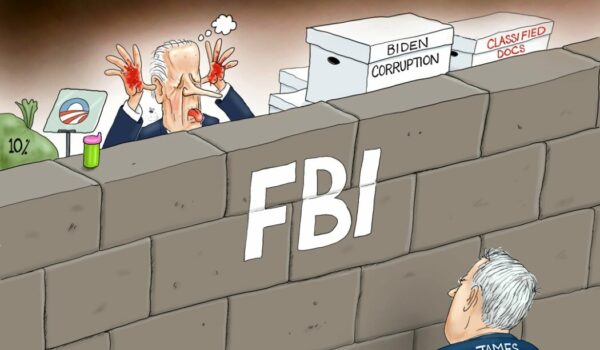
A judge has issued an injunction against the race-based Business Center Program created under Biden’s Infrastructure Act. Its Minority Business Development Agency provisions limit aid to businesses owned by people of particular races. It is another major ruling against racial preferences obtained by the Wisconsin Institute for Law and Liberty (WILL). WILL also obtained an injunction against racial preferences in Biden’s stimulus package that effectively reserved COVID relief for minority-owned small businesses rather than those owned (or half-owned) by whites.
Tuesday’s ruling is very significant because its logic calls into question the validity of racial preferences that benefit some racial and ethnic minorities but not others, without a clear explanation of why some are included and others are not. That makes it easier to bring a lawsuit challenging racial preferences, even when the government hired a statistician to come up with a “disparity study,” a study that supposedly justifies a racial preference. A clever statistician can often torture the data to make it appear like at least some racial preference is justified to remedy the supposed effects of past discrimination against blacks. Because racial preferences are actually motivated by crass politics, not the desire to remedy past discrimination, they often are doled out to racial and ethnic minorities based on their political pull, not whether they were subjected to any discrimination in the recent past (in the distant past, blacks were often discriminated against, but many ethnic and racial groups have never faced systemic discrimination in many localities).
As a law professor explains,
On Tuesday, in Nuziard v. Minority Business Development Agency (MBDA) federal district court judge Mark T. Pittman issued an injunction against the MBDA’s Business Center Program. These Centers may give assistance only to businesses owned by socially or economically disadvantaged individuals. A Business owned by a “Black, African American, Hispanic, Latino, American Indian, Alaska Native, Asian, Native Hawaiian, Pacific Islander, Puerto-Rican, Eskimo, Hasidic Jew, Asian Indian, or a Spanish-speaking American,” is presumptively considered to be owned by a socially or economically disadvantaged individual. According to the opinion, and unlike similar federal programs, no individual outside of the designated groups can be eligible, no matter how socially or economically disadvantaged.
Most interesting from my perspective, Judge Pittman focused on the arbitrariness of the relevant classifications:
[T]he Program is not narrowly tailored because it is underinclusive and overinclusive in its use of racial and ethnic classification… It is underinclusive because it arbitrarily excludes many minority-owned business owners—such as those from the Middle East, North Africa, and North Asia. For example, it excludes those who trace their ancestry to Afghanistan, Iran, Iraq, and Libya. But it includes those from China, Japan, Pakistan, and India. The Program is also underinclusive because it excludes every minority business owner who owns less than 51% of their business.
In researching my book Classified, I hoped and really expected to find cases involving two issues that have received very little attention in the relevant academic literature.
First, what happens when a government agency rejects someone’s claim to be a member of a designated minority group eligible for affirmative action? The conventional wisdom is that only one such case existed, involving Irish-American firefighters who claimed to be black. That struck me as very unlikely. My intuition was correct. I found a couple of dozen or so additional modern cases in which a party’s racial status was adjudicated.
Second, while the Supreme Court has never directly addressed the issue, I thought there must be a fair number of cases discussing whether the classifications a government entity has adopted for affirmative action cases pass constitutional muster under the strict scrutiny test, which requires both a compelling government interest and the law be narrowly tailored to serve that interest. In other words, discussion not simply of whether affirmative action preferences are constitutional in the abstract as serving a compelling government interest, but whether the groups that are included and excluded meet the narrow tailoring requirement.
I was disappointed on that one. Very few cases address the issue, except in passing. The leading case, such as it is, is Peightal v. Metropolitan Dade County, 940 F.2d 1394 (11th Cir. 1991). In that case, the Eleventh Circuit held that while the decision to classify people by race and provide an affirmative action benefit to certain groups is subject to strict scrutiny, once a court concludes that the program itself meets the compelling interest test, if challenged the classification scheme used by the government is subject only to the very forgiving rational basis test.
Peightal seems obviously wrong. It’s entirely implausible to me to read the Supreme Court’s binding jurisprudence on these matters as saying that once the government demonstrates a compelling interest in racial and ethnic preferences, it can allocate those preferences in almost any way it desires.
I suspect that one reason Peightal came out as it did is that it would be very difficult if not impossible for the government to create a classification scheme for affirmative action that would meet the strict scrutiny/narrow tailoring requirement. The court wasn’t prepared to issue a ruling that would call almost all racial preference programs into question, so it punted.
Judge Pittman acknowledged the problem in a footnote: “Fashioning a racial or ethnicity-based policy that is not underinclusive or overinclusive is extremely difficult and almost impossible in a multiethnic country like the United States.” The logical inference to draw from this fact is not that courts should ignore the narrow tailoring requirement, but that racial and ethnicity-based policies are almost always unconstitutional.
Judge Pittman’s ruling Nuziard called to mind Judge Amul Thapar’s opinion in Vitolo v. Guzman, 999 F.3d 353 (6th Cir. 2021),which came out just as I was finishing my book manuscript:
The government’s policy is plagued with other forms of underinclusivity. Consider the requirement that a business must be at least 51% owned by women or minorities…
The dispositive presumption enjoyed by designated minorities bears strikingly little relation to the asserted problem the government is trying to fix. For example, the government attempts to defend its policy by citing a study showing it was harder for black business owners to obtain loans from Washington, D.C., banks. Gov’t Resp. 15. Rather than simply designating those owners as the harmed group, the government relied on the Small Business Administration’s 2016 regulation granting racial preferences to vast swaths of the population. For example, individuals who trace their ancestry to Pakistan and India qualify for special treatment. But those from Afghanistan, Iran, and Iraq do not. Those from China, Japan, and Hong Kong all qualify. But those from Tunisia, Libya, and Morocco do not. This scattershot approach does not conform to the narrow tailoring strict scrutiny requires.
The stark realities of the Small Business Administration’s racial gerrymandering are inescapable. Imagine two childhood friends—one Indian, one Afghan. Both own restaurants, and both have suffered devastating losses during the pandemic. If both apply to the Restaurant Revitalization Fund, the Indian applicant will presumptively receive priority consideration over his Afghan friend. Why? Because of his ethnic heritage. It is indeed “a sordid business” to divide “us up by race.”
Occasionally, state affirmative-action plans have been struck down, even when there was supposedly evidence of discrimination against blacks and Hispanics that warranted a racial preference “remedy,” solely because the affirmative-action plan included groups that had never been discriminated against by the government in the state in question. For example, the New Jersey Appellate Division did so in L. Feriozzi Concrete Co. v. Casino Reinvestment Dev. Auth. (2001).



